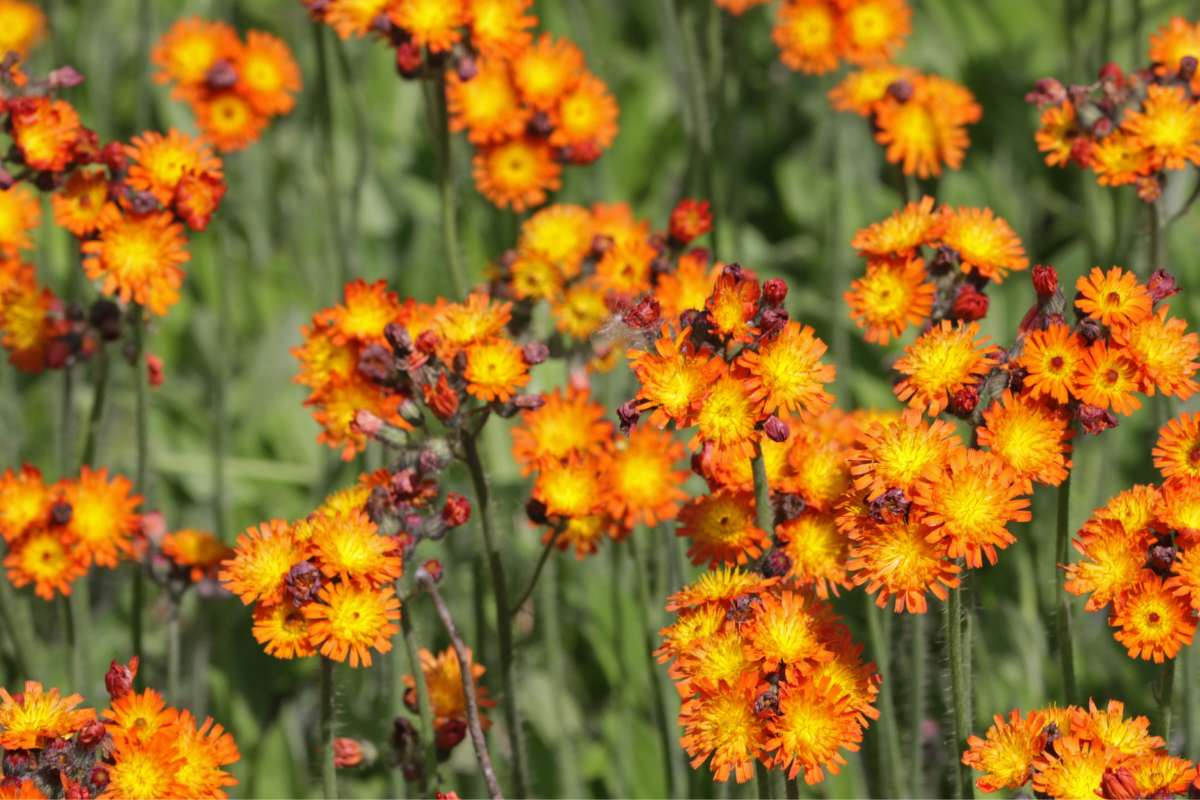
Breathtaking landscapes surround Washington State, but along with them comes a common challenge: dealing with weeds. These unwelcome plants can quickly take over our gardens, lawns, and open spaces if we don’t take action. In this article, we’ll dive into the most common weeds in Washington State, helping you identify and effectively control them.
Common Lawn Weeds
In Washington, you may find a variety of unwelcome guests — common lawn weeds that can frustrate and affect the beauty of your lawn.
However, alongside these culprits, there are also noxious weeds in Washington that, while not as prevalent in lawns, pose potentially greater risks. Join us as we delve into the realm of both common and noxious weeds:
Crabgrass (Digitaria sanguinalis)
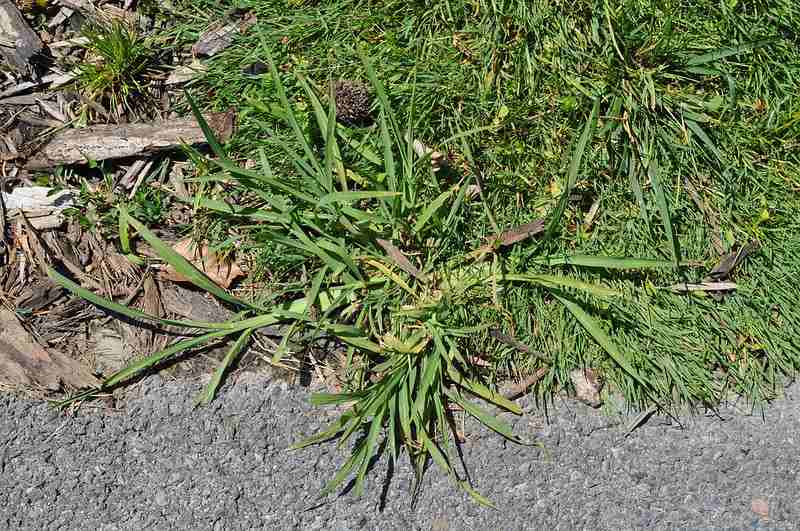
Crabgrass is a common lawn weed that can quickly take over your yard if left unchecked. It thrives in sunny and bare areas, appearing during the warmer months. Crabgrass is characterized by its low-growing habit and distinctive crab-like stems.
Life cycle: Summer annual
Weed type: Grass weed
Where it thrives: Warm, dry conditions, with poor soil
How to identify crabgrass:
- Long, finger-shaped leaves that sprawl out from a center stem
- Grows low to the ground
- Leaf blades have a wider width than common grasses
- Coarse texture
How to get rid of crabgrass: Fertilize your grass with nitrogen during spring and fall to promote rapid growth, so the lawn shades crabgrass seedlings and inhibits their growth. Consider using pre-emergent herbicides containing dithiopyr, pendimethalin, prodiamine, and benefin + trifluralin in early spring.
Chickweed (Stellaria media)
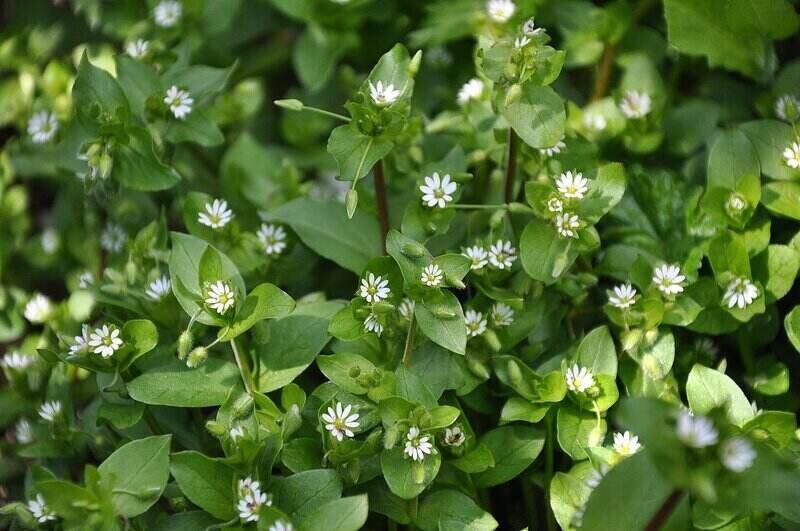
Chickweed, a common lawn weed, is characterized by its delicate white blossoms. Its presence often indicates moist or poorly drained soil conditions. This opportunistic weed can quickly establish itself in the spring, forming a dense mat that can crowd out desired plants.
Life cycle: Winter annual
Weed type: Broadleaf
Where it thrives: Moist, shaded areas with soil
How to identify chickweed:
- Small, oval-shaped leaves that grow opposite each other
- Leaves have a pointed tip and a smooth margin
- Thin and green stem
- Small white flowers
How to get rid of chickweed: Hand pulling chickweed is a straightforward and practical approach, ensuring the removal of weeds from the root. To prevent weed seeds from germinating, applying a layer of mulch about 2 to 3 inches thick is recommended. Additionally, pre-emergence herbicides containing triclopyr, and 2,4-D dimethylamine can be utilized.
Clover (Trifolium repens)
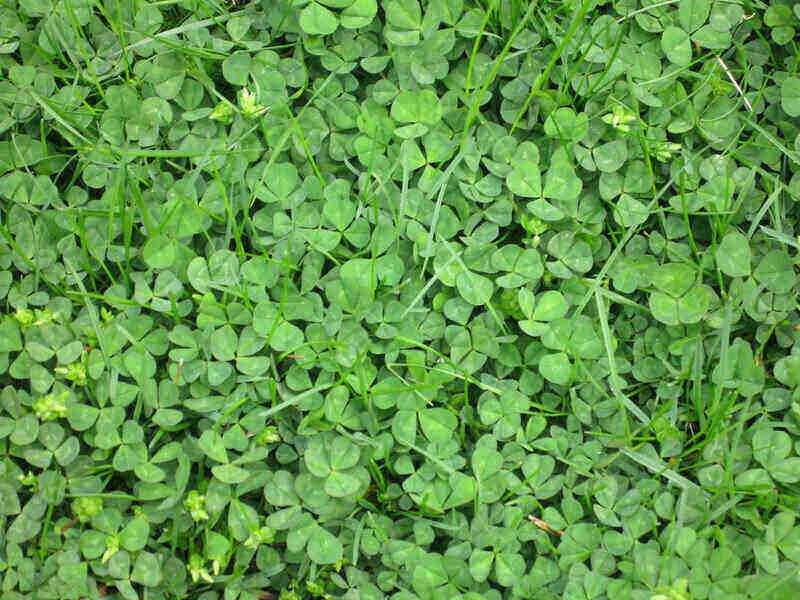
White clover, a familiar sight in many lawns, is known for its distinct trifoliate leaves and small white flowers. And if you’re really lucky, you might even stumble upon a leaf with four leaflets. While some consider it a weed, it can add a touch of charm and greenery to a space, which is why some people consider planting a clover lawn.
Life cycle: Perennial
Weed type: Broadleaf
Where it thrives: Prefers full sun, but can grow in shade with proper fertilization
How to identify clover:
- Three small, oval leaflets
- Grows in patches close to the ground
- White flowers tinged with pink in early spring
How to get rid of clover: It is helpful to improve turf density with good establishment procedures and by choosing turfgrasses well-adapted to Washington. Apply herbicides containing triclopyr and 2,4-D in fall.
Henbit (Lamium amplexicaule)
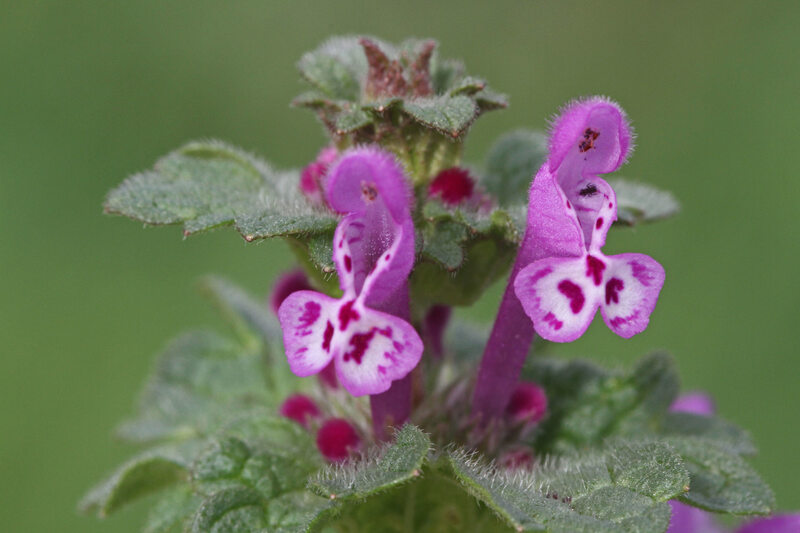
Henbit, named for its popularity among chickens, is a common weed that takes advantage of thin, moist, and shaded areas in your lawn. This opportunistic plant can quickly establish itself, forming dense patches. With its purple flowers and square stems, henbit adds a touch of color to your lawn, but it can quickly become an unwelcome guest.
Life cycle: Winter annual
Weed type: Broadleaf
Where it thrives: Moist, cool areas but tolerates full-sun
How to identify henbit:
- Pink to purple flowers, with dark purple spots
- Round and scalloped leaves, clasping directly from the stem
- Generally sprawling or low-growing
How to get rid of henbit: The best way to get rid of henbit is to treat it with herbicides containing triclopyr and 2,4-D in spring, before it blooms. You can also hand-pull it and add a layer of mulch to help suppress its growth.
Bonus: Moss
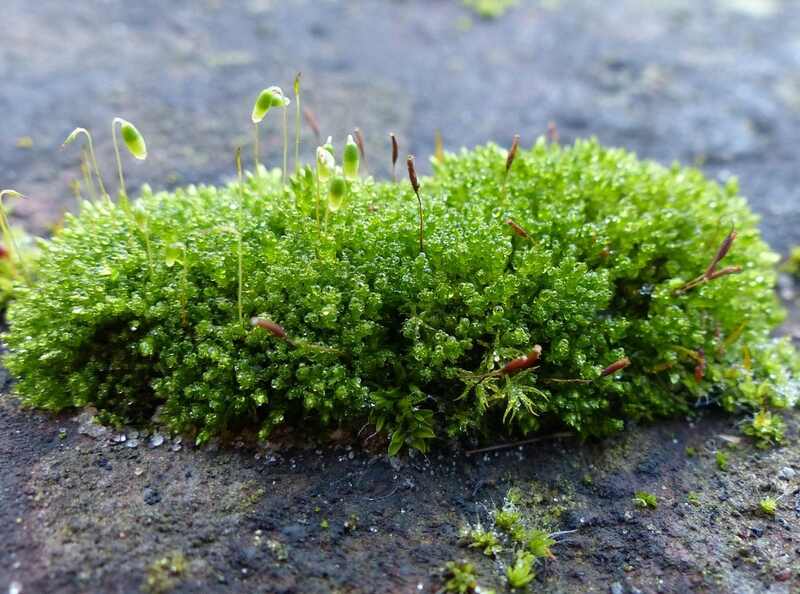
While not classified as a weed, moss can present challenges in maintaining a healthy lawn. It tends to thrive in areas where grasses are thin and weak, inhibiting grass growth.
To remove moss from your lawn, proper lawn management procedures are essential, such as:
- Raking
- Dethatching
- Aerating
- Adjusting nutrient levels in your lawn, such as through fertilization, or adding lime
- Applying glyphosate-based post-emergent herbicides
- Applying iron sulfate
What are Noxious Weeds?
Noxious weeds are a distinct category of weeds “designated by a Federal, State or county government as injurious to public health, agriculture, recreation, wildlife, or property.” They cause so many problems because they grow fast and don’t have natural enemies in Washington. They can be very destructive, competitive, and hard to control.
The Washington State Noxious Weed Control Board decides which plants go on the Washington State Noxious Weed List, and they’re divided into three levels of classification: Class A, Class B, and Class C.
Now, besides noxious weeds, there are other types of weeds too. They may not be as harmful as noxious weeds, but they can still be annoying. You might have heard of some of them, like dandelions, crabgrass, and chickweed.
Class A Noxious Weeds
Class A noxious weeds in Washington State are the most severe and urgent threat. They must be eradicated wherever they appear because they have limited distribution but possess the potential to spread quickly and cause significant harm.
Garlic Mustard (Alliaria petiolata)
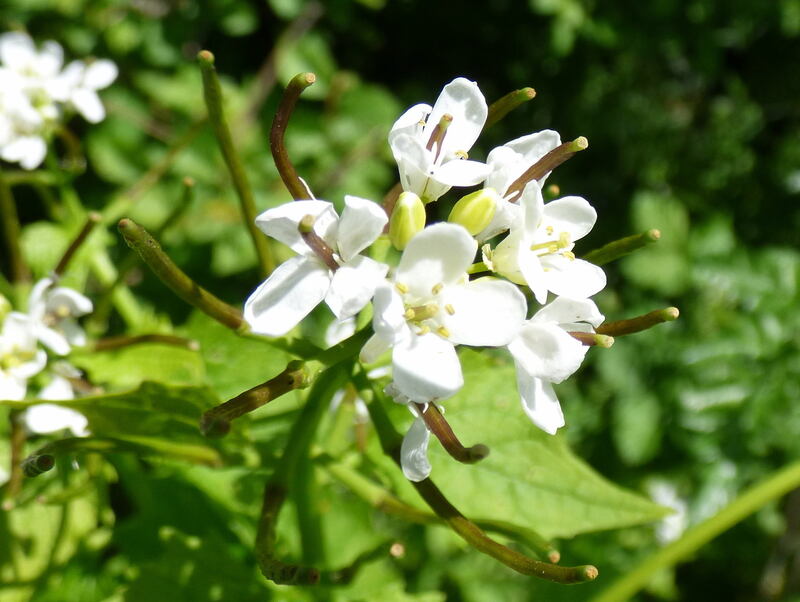
Garlic mustard exudes chemicals from its roots that inhibit the growth of surrounding plants, disrupting the delicate balance of ecosystems. Additionally, it produces up to 5,000 seeds from a single plant. This combination of chemical warfare and prolific seed production allows garlic mustard to colonize and dominate areas rapidly, outcompeting native plant species.
Life cycle: Biennial
Weed type: Broadleaf, herbaceous plant
Where it thrives: Partial to full shade, and well-drained, nutrient rich soils
How to identify garlic mustard:
- Leaves have a garlic odor when crushed
- Leaves are triangular to heart-shaped, with scalloped edges
- Small white flowers with four petals that form a cross appear in clusters in early spring
How to get rid of garlic mustard: Target the plants during the flowering stage before they produce seeds. Grasp them at the base to remove the entire root system. Bag and adequately dispose of the pulled plants to prevent further spread, and revisit the sites to address any re-sprouting plants that may arise. Herbicides containing glyphosate or triclopyr can also be used.
Giant Hogweed (Heracleum mantegazzianum)
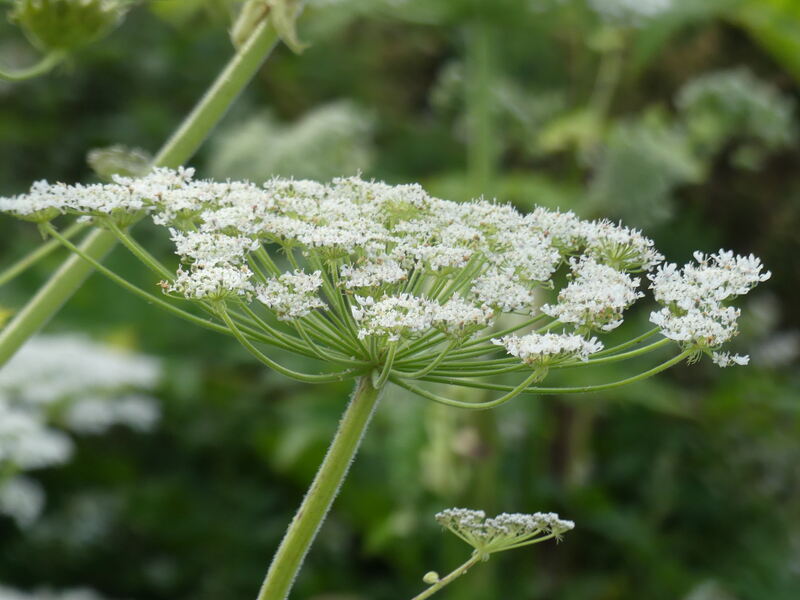
This weed contains toxic sap that can cause severe burns to the skin, resulting in long-lasting scars. A mere brush against its leaves or stems can unleash a painful encounter. Moreover, if left unchecked, giant hogweed can rapidly overrun flower beds and other garden areas, jeopardizing the beauty and health of green spaces.
Life cycle: Short-lived perennial
Weed type: Broadleaf, herbaceous plant
Where it thrives: Partial shade, and nutrient-rich, moist soils
How to identify giant hogweed:
- Leaves grow 3 to 5 feet wide, are incised and deeply lobed
- Looks like the native cow parsnip, but larger
- Clusters of white flowers shaped into an umbrella
- Stems have purple splotches and coarse white hairs
- Reaches heights of 10 to 15 feet
How to get rid of giant hogweed: Due to its harmful nature, caution should be exercised to avoid direct contact — wear gloves and protective clothing. For seedlings and young plants, carefully dig them up. Cut back the plant using loppers or similar tools for larger plants and then dig up the entire plant, including the root crown.
Italian Thistle (Carduus pycnocephalus)
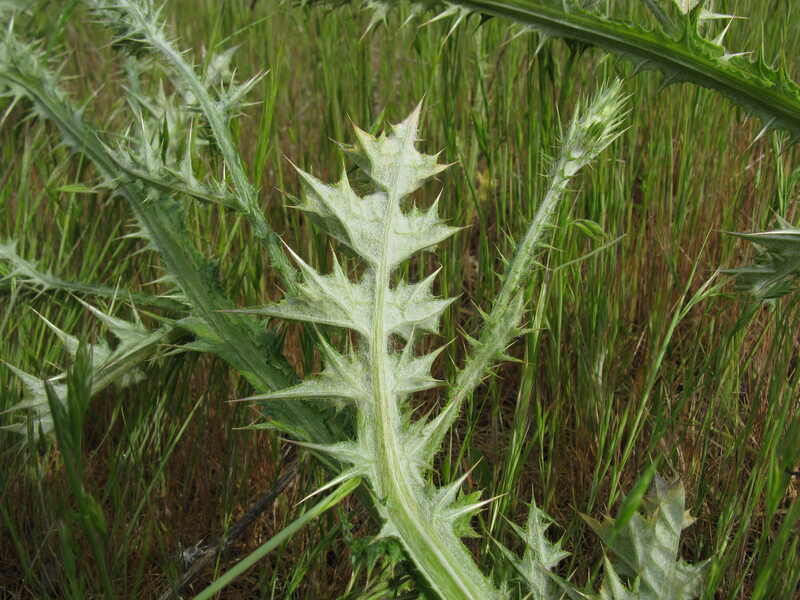
Italian thistle, an unwanted intruder, aggressively invades rangeland and pastures, overpowering desirable forage and native plants. Its presence creates dense stands that hinder livestock grazing, disrupting the balance of these ecosystems.
Life cycle: Annual or sometimes biennial
Weed type: Broadleaf, herbaceous plant
Where it thrives: Full sun, and well-drained soils
How to identify Italian thistle:
- Grows 6 to 8 feet in height
- Spiny, winged stems
- Leaves are green, lobed, and have cobwebby hairs on the undersides
- Flowers are purple, narrow, with stiff and hairy bracts
How to get rid of Italian thistle: Digging, hand-pulling, and tilling are effective control methods for small infestations. For large infestations or for rural sites, consider applying herbicides containing aminopyralid, glyphosate, or triclopyr amine.
Silverleaf Nightshade (Solanum elaeagnifolium)
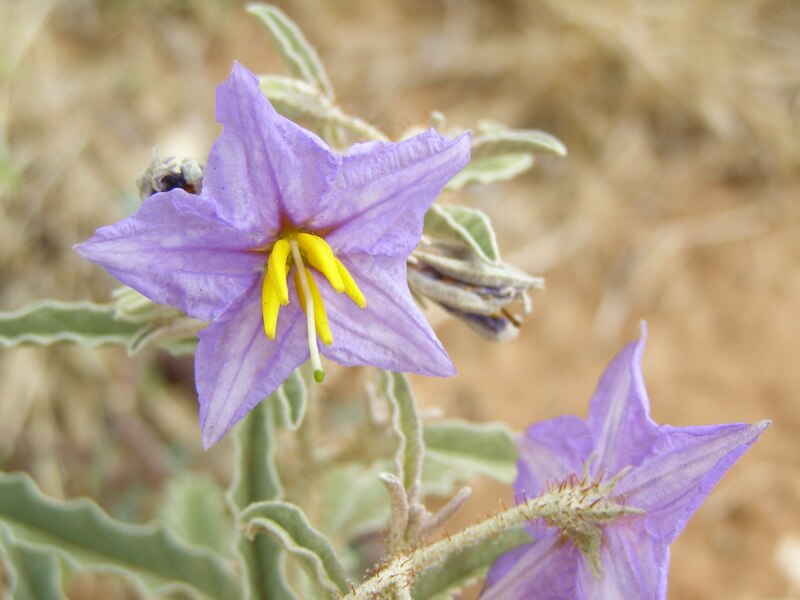
Silverleaf nightshade, a troublesome plant, poses a double threat to agricultural landscapes. First, this invasive weed competes vigorously with crops, leading to lower yields and economic losses for farmers. Additionally, it is dangerous to livestock, as it is toxic when consumed.
Life cycle: Perennial
Weed type: Broadleaf, herbaceous plant
Where it thrives: Full sun, and loamy, droughty soils
How to identify silverleaf nightshade:
- Lance-shaped leaves with silvery-white hairs
- Blue or violet flowers with 5 fused petals
- Grows 1 to 4 feet
- Stems have yellow spines
How to get rid of silverleaf nightshade: Plants must be removed entirely, being careful to get all the rootstock. Dispose of it correctly, in trash bags. This weed is difficult to control with herbicides; prefer the ones containing glyphosate.
Oriental Clematis (Clematis orientalis)
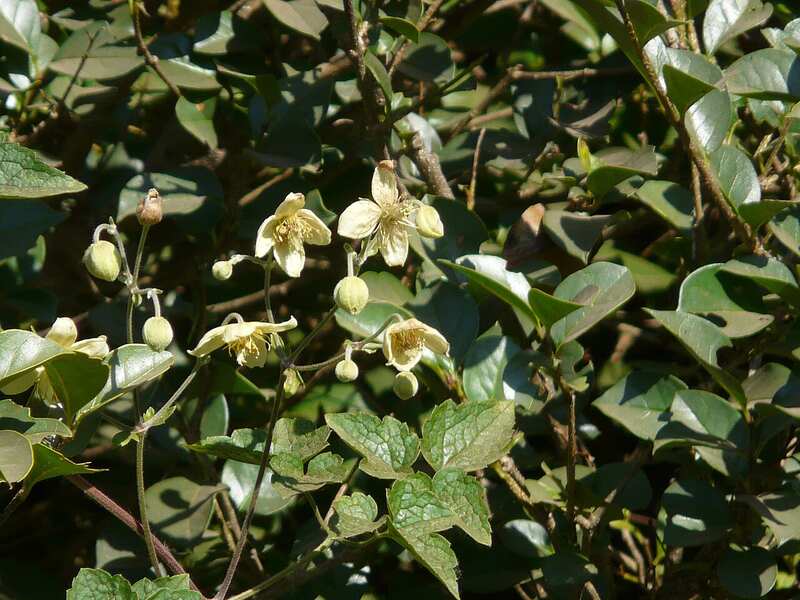
The Oriental clematis is a vigorous climber that establishes dense infestations, overpowering and suppressing native vegetation. This invasive plant’s aggressive growth can even lead to the demise of small trees, as the vines weigh them down and weaken their structure. Furthermore, the juice of freshly crushed leaves and stems may cause blistering.
Life cycle: Perennial
Weed type: Broadleaf vine or scrambling shrub
Where it thrives: Full sun, well-drained soils
How to identify oriental clematis:
- Flowers are yellow to green, with sepals that curve back at maturity
- Seedheads look like pom-poms
- Leaves are opposite, and pinnately compound
- Grows up to 27 feet long
How to get rid of Oriental clematis: Pull lower vines off of trees and structures and remove any lower stems by the roots. Discard them in garbage bags. For larger patches, herbicides containing imazapyr, picloram, and glyphosate were effective in initial trials.
Class B Noxious Weeds
Class B noxious weeds significantly threaten uninfested areas and require containment measures.
Purple Loosestrife (Lythrum salicaria)
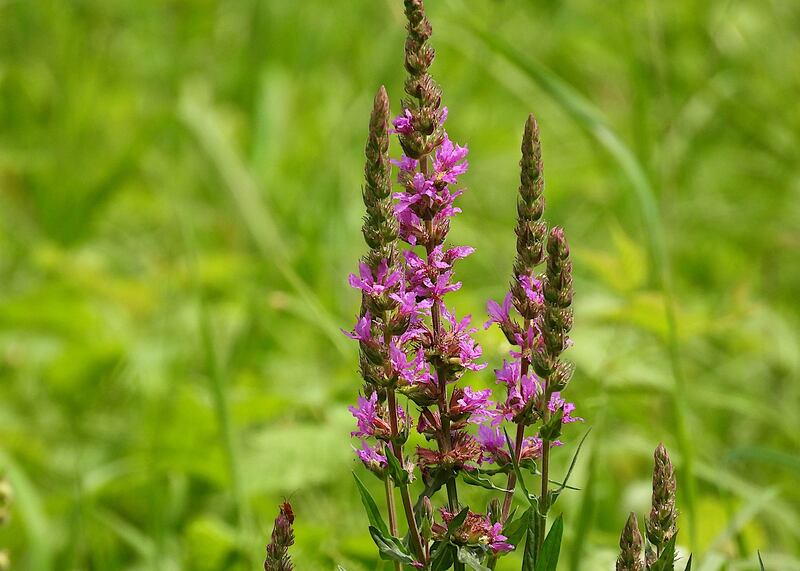
Purple loosestrife is often found near bodies of water, and it catches our attention with its pretty magenta flower spikes. But don’t let its beauty fool you. This invasive plant can cause trouble. It grows quickly and forms dense stands, pushing out native plants.
Life cycle: Perennial
Weed type: Broadleaf, herbaceous plant
Where it thrives: Full sun, freshwater marshes
How to identify purple loosestrife:
- Tall, narrow spikes of purple-magenta flowers
- Grows 6 – 10 feet tall
- Leaves are opposite or whorled, lance-shaped, and stalkless
- Seeds are the size of a ground pepper grain and travel by water and birds
How to get rid of purple loosestrife: The most suitable method depends on the extent of the infestation. In areas where there are few young plants, manual removal is recommended. Carefully dig out the plants, removing as much of the root system as possible to prevent regrowth. If the weed is located in an aquatic site and you plan on applying herbicides, ensure you’re getting aquatic formulations of glyphosate.
Butterfly Bush (Buddleja davidii)
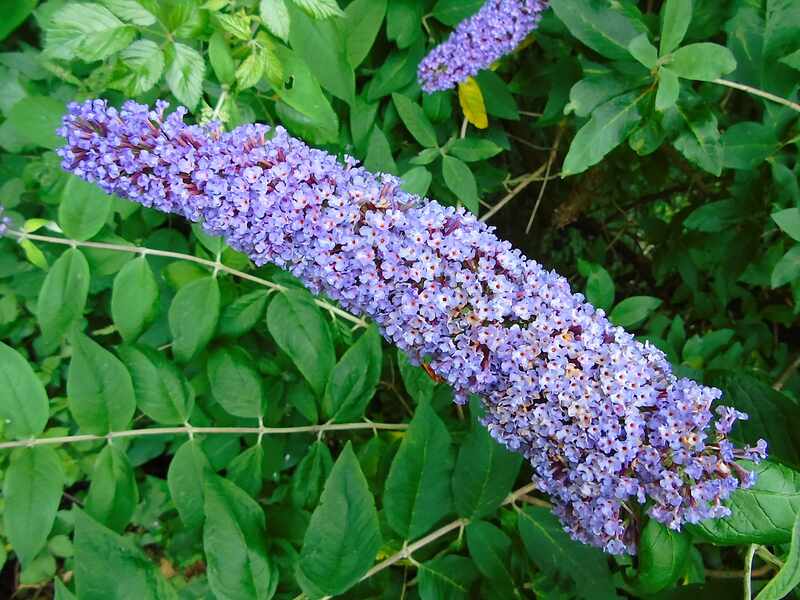
The butterfly bush is notorious for forming dense thickets, particularly along river banks and gravel bars. This invasive shrub poses a significant threat as it crowds out native vegetation and disrupts the natural balance of ecosystems. Its aggressive growth alters soil nutrient concentrations, further impacting surrounding plant communities.
Life cycle: Perennial
Weed type: Broadleaf shrub
Where it thrives: Full sun, and well-drained soils
How to identify butterfly bush:
- Arching branches up to 15 feet tall
- Long, drooping purple flower spikes
- Stems and leaves are hairy
How to get rid of butterfly bush: Never let this plant go to seed, as a single flower spike can produce over 40,000 seeds. Pull seedlings and dig out larger bushes. Dispose of them in garbage bags. Cut-stump herbicide applications are also effective.
Scotch Broom (Cytisus scoparius)
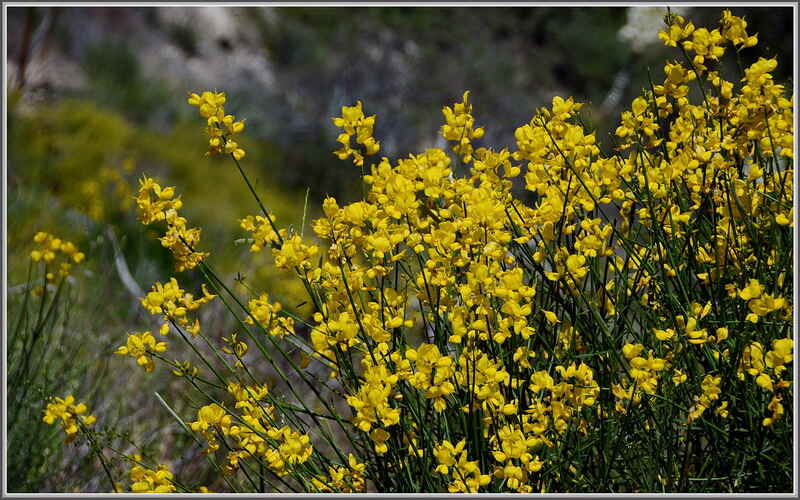
Scotch broom, a tall and invasive shrub, poses a significant threat to natural ecosystems. This plant displaces native and beneficial plants, leading to the loss of grassland areas and hindering reforestation efforts. It spreads aggressively, forming monocultures that dominate the landscape. Additionally, the seeds of Scotch broom are toxic to livestock and horses.
Life cycle: Perennial
Weed type: Broadleaf shrub
Where it thrives: Full sun, and dry, sandy soils
How to identify Scotch broom:
- Bright yellow flowers with 5 petals
- Few leaves pointed at both ends
- Stems are woody and dark green
- Seed pods are legume-like
How to get rid of Scotch broom: If the plant is shorter than 3 feet, hand-pull it when the soil is moist. Larger plants should be wrenched out with weeding tools near ground level. Seedlings that survive can be sprayed with selective herbicides.
Knotweeds
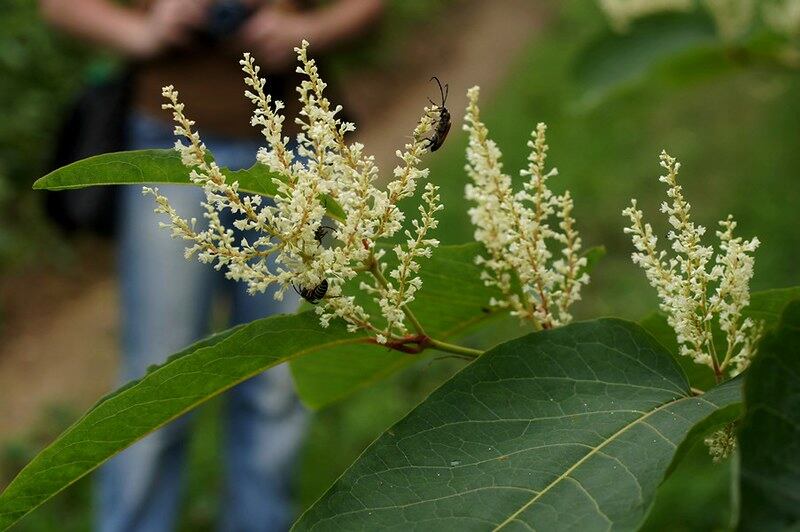
Knotweed species, including the giant knotweed (Polygonum sachalinense), Japanese knotweed (Polygonum cuspidatum), and Himalayan knotweed (Persicaria wallichii) are renowned troublemakers. They clog waterways, erode riverbanks, and can even cause structural damage. Moreover, they have a knack for crowding out other vegetation.
Life cycle: Perennial
Weed type: Broadleaf shrub
Where it thrives: Prefers full sun and riparian areas like stream banks
How to identify knotweed:
- The giant knotweed has elongated, heart-shaped leaves
- The Japanese knotweed has smaller, oval-shaped leaves
- The Himalayan knotweed features long and narrow leaves
- They all feature small, creamy white clusters of flowers
How to get rid of knotweed: Relying solely on mechanical methods is not enough for dealing with knotweed. The key to successful eradication is addressing its extensive underground system of rhizomes. Consider combining mechanical and chemical control methods (preferably with imazapyr) for effective results.
Sulfur Cinquefoil (Potentilla recta)
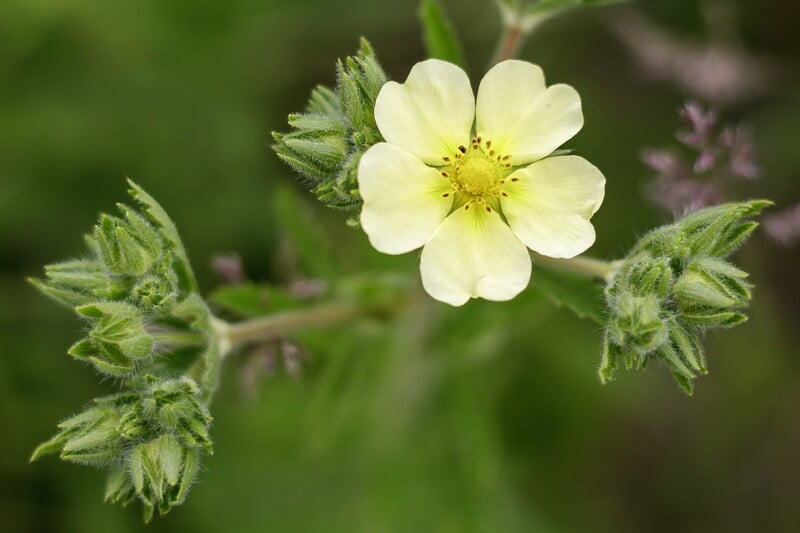
Sulfur cinquefoil can establish vast monocultures, dominating large areas and outcompeting grasses. This invasive plant exhibits strong competitive traits, challenging native vegetation. Its distinct leaves consist of five to seven narrow leaflets, each with toothed edges.
Life cycle: Perennial
Weed type: Herbaceous plant
Where it thrives: Full to partial sun, and rocky, or low-nutrient soils
How to identify sulfur cinquefoil:
- Stems are leafy, hairy, and usually unbranched
- Flowers are pale yellow with five heart-shaped petals
- Leaves are palmately lobed
How to get rid of sulfur cinquefoil: This weed is difficult to control once established and must be reported to the county’s weed program. Mechanical control can be enough for small infestations if you remove as much root as possible. Selective herbicides containing triclopyr, 2,4-D, or dicamba will be necessary for larger infestations.
Poison Hemlock (Conium maculatum)
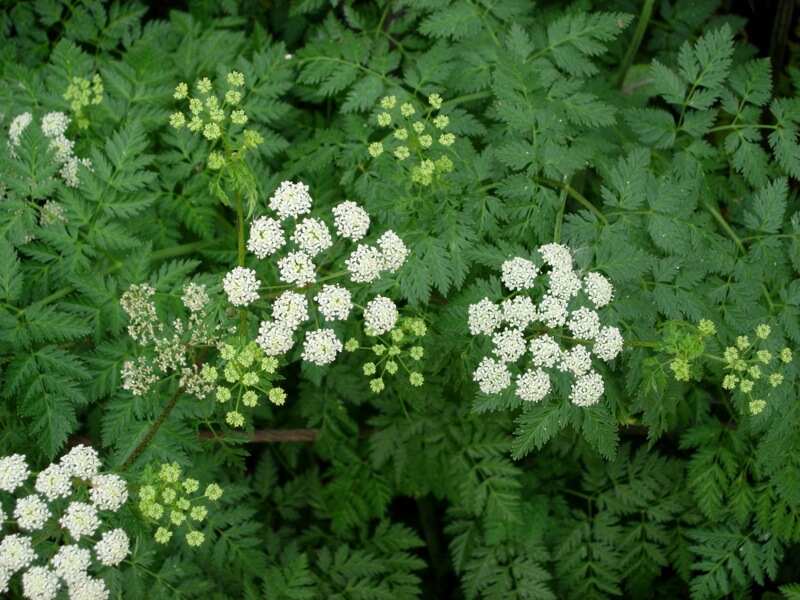
Poison hemlock is a highly toxic plant that poses a deadly threat to animals and humans. Growing up to 12 feet in height, it towers over surrounding vegetation. Its long taproot aids in its ability to establish and thrive. This invasive weed has the alarming capacity to rapidly infest large areas of pasture and open waste places, where it outcompetes native plants.
Life cycle: Biennial
Weed type: Broadleaf, herbaceous plant
Where it thrives: Shaded areas, and moist soils
How to identify poison hemlock:
- Stems have reddish-purple spots
- Grows like a carrot in the first year
- Develops tall stems and umbrella-shaped clusters of flowers in the second year
How to get rid of poison hemlock: Using gloves, pull or dig up plants, carefully removing the entire taproot. Don’t leave any flower heads on the ground. Plant other species on site to discourage the weed from re-establishing. Report all populations of this plant to the county weed program.
Spurge Laurel (Daphne laureola)
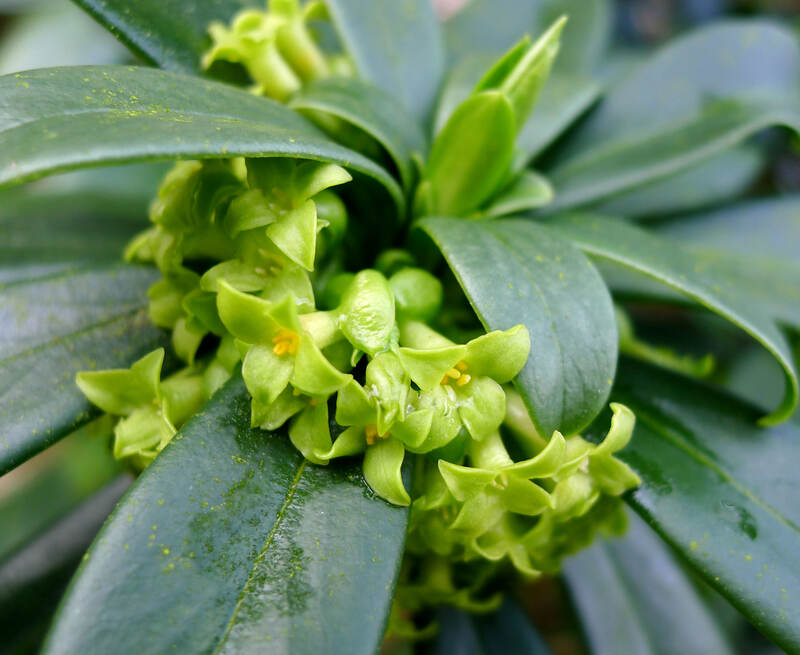
Spurge laurel poses risks due to its poisonous nature. Its leaves, bark, and berries contain toxins that can harm humans and animals. Additionally, spurge laurel has a remarkable ability to colonize areas, forming dense stands and outcompeting native plants.
Life cycle: Perennial
Weed type: Broadleaf shrub
Where it thrives: Full to partial shade, and well-drained soils
How to identify spurge laurel:
- Spurge laurel has long oblong leaves spirally arranged
- It has honey-scented yellow-green clusters of flowers that grow between the leaves
- It has green, egg-shaped fruits that turn black when they ripen
How to get rid of spurge laurel: For small infestations, carefully hand dig the entire plant, including the roots, taking caution due to its toxic nature, and dispose of it in plastic bags (avoid composting). After cutting the plant near the ground, you can also apply an herbicide containing triclopyr to the stump.
Herb-Robert (Geranium robertianum)
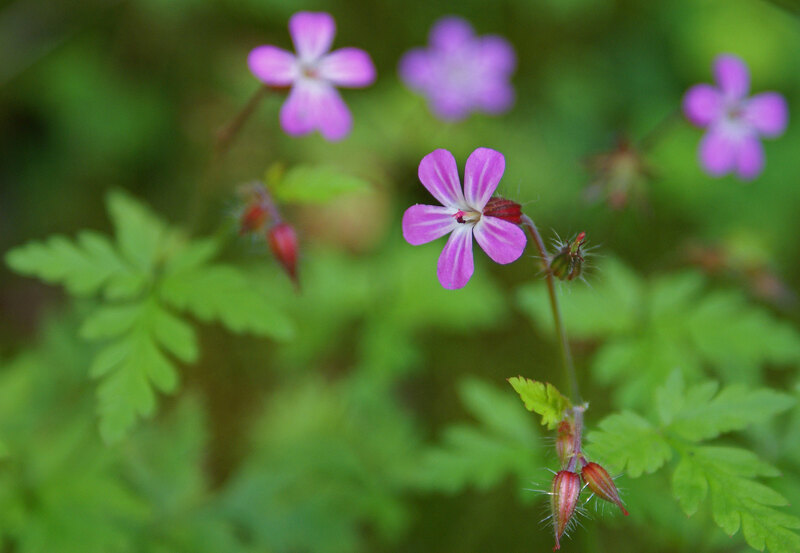
Herb-Robert, commonly known as “stinky Bob,” is a tenacious and invasive weed that can thrive even in densely shaded areas. It earns its nickname from the pungent odor it emits when crushed. Herb-Robert may seem visually appealing with its pink flowers, but make no mistake — it will compete with Washington’s native plants.
Life cycle: Winter and spring annual or biennial
Weed type: Broadleaf, herbaceous plant
Where it thrives: Shady areas, and well-drained soils
How to identify Herb-Robert:
- Pink flowers with five petals
- Red stems with white hairs
- Deeply dissected green leaves
How to get rid of Herb–Robert: Preventing seed production is key when dealing with Herb-Robert. Plants must be removed before they produce flowers and seeds, then bagged and properly disposed of. Herbicides containing glyphosate, imazapyr, and triclopyr + 2,4-D can also be used.
Tansy Ragwort (Jacobaea vulgaris)
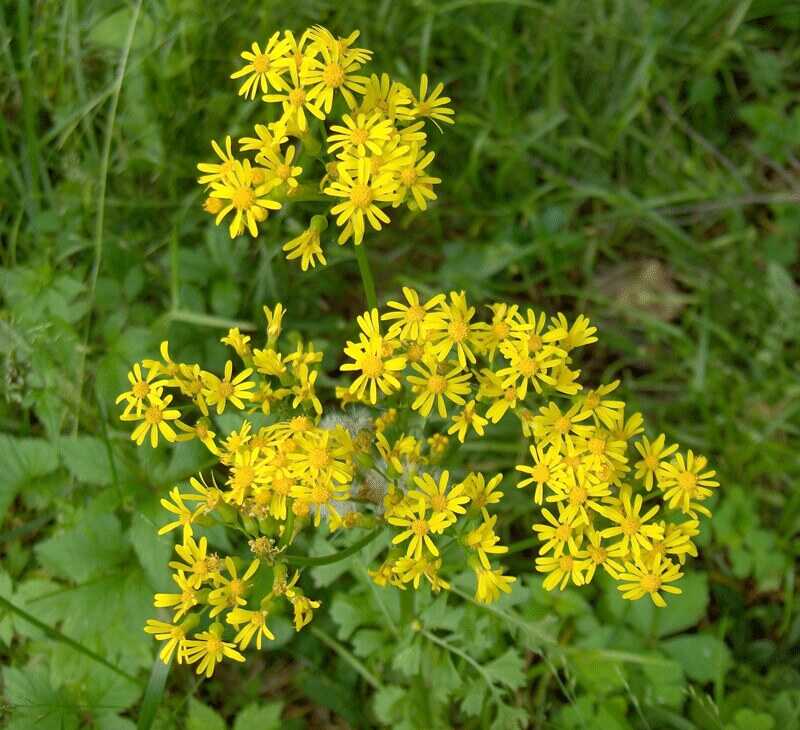
Due to its poisonous nature, Tansy ragwort poses a significant risk to cattle, horses, some goats, pets, and people. Livestock that consumes tansy ragwort can suffer from liver damage and other health complications. These toxic properties also raise concerns for humans as they can be transferred through the food chain, potentially causing harm.
Life cycle: Biennial, short-lived perennial, or sometimes a winter annual
Weed type: Broadleaf, herbaceous plant
Where it thrives: Full to partial sun, and well-drained loamy to sandy soils
How to identify tansy ragwort:
- Yellow flowers are arranged in flat-topped clusters
- Leaves are dark green on top, whitish-green underneath, with deeply cut, blunt-toothed lobes
- Grows 2 to 4 feet tall
How to get rid of tansy ragwort: It is necessary to combine treatments with revegetation to control this weed. Dig up or pull the entire plant, including roots, and bag it before discarding it. Do not mow over it. A broad range of herbicides can be used. Reseed the affected area with fast-growing grasses to establish competition.
Yellow Archangel (Lamiastrum galeobdolon)

Yellow archangel is an exceptionally challenging weed to eradicate once it takes root. This invasive plant escapes from residential plantings and spreads rapidly, forming dense mats of ground cover vegetation. Its invasive nature allows it to outcompete native plant species, leading to a reduction in biodiversity.
Life cycle: Perennial
Weed type: Broadleaf, herbaceous plant
Where it thrives: Part sun to full shade, and moist soils
How to identify yellow archangel:
- Silvery green leaves
- Leaves are oppositely arranged, oval-shaped, toothed, and hairy
- Flowers are small, yellow, and grow in pairs
How to get rid of yellow archangel: Treatment and revegetation must be combined to eliminate this pesky weed. Roots are not deep, so plants can be hand-pulled, but be careful not to leave even a tiny bit of root. Herbicides containing glyphosate, imazapyr, or triclopyr are effective, but you may need to reapply them to surviving plants.
Orange Hawkweed (Hieracium aurantiacum)
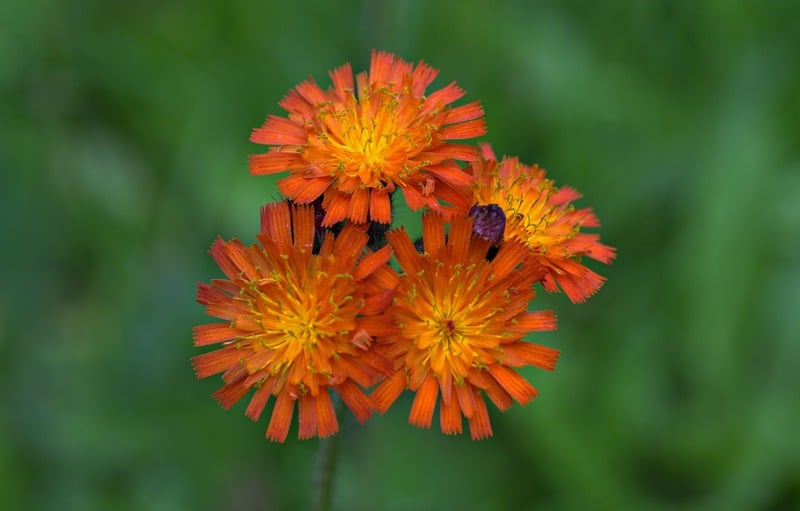
The orange hawkweed is an insidious competitor, outcompeting and overshadowing more desirable forage and disrupting the natural balance of ecosystems. Its rapid spread and ability to establish dense populations make it a persistent and troublesome presence.
Life cycle: Perennial
Weed type: Broadleaf, herbaceous plant
Where it thrives: Full sun or partial shade, and well-drained, sandy soils
How to identify orange hawkweed:
- Flowers are bright red-orange to yellow, arranged in clusters of five or more
- Hairy leaves are arranged in a low-growing basal rosette and are spatula-shaped
- Grows 10 to 24 inches tall
How to get rid of orange hawkweed: Small infestations can be hand-pulled or dug up, making sure to dig deeply to remove belowground rhizomes and fibrous roots. Herbicides (2,4-D or clopyralid) can also be effective when sprayed in the rosette stage.
Spotted Knapweed (Centaurea stoebe)
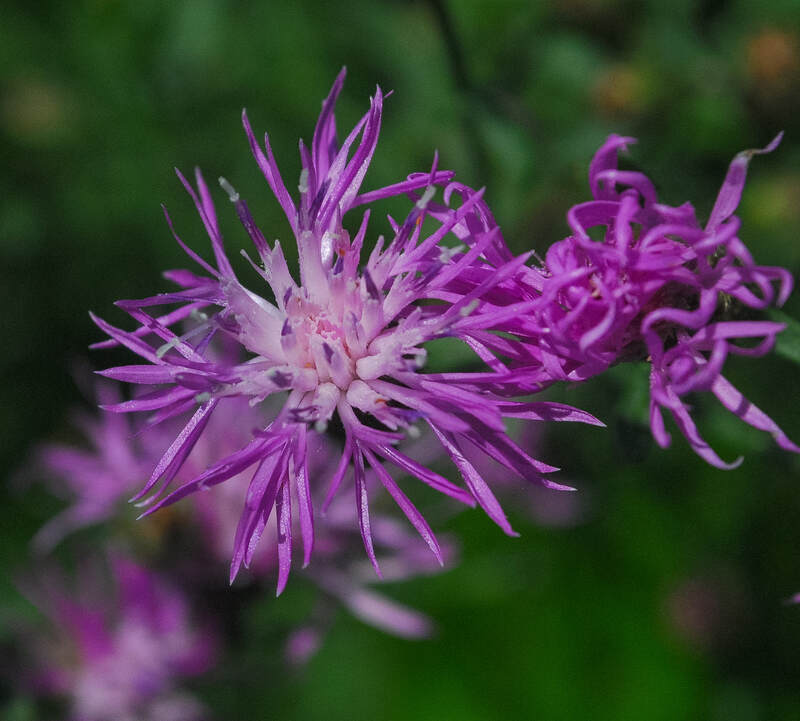
The spotted knapweed not only disrupts natural habitats and plant diversity but also contributes to soil erosion and heightened wildfire hazards. Its ability to quickly degrade wildlife habitat and ecological balance makes it a significant concern. Therefore, combating the spread of spotted knapweed is crucial in Washington.
Life cycle: Biennial or short-lived perennial
Weed type: Broadleaf, herbaceous plant
Where it thrives: Full sun, and dry, sterile, gravelly or sandy soils
How to identify spotted knapweed:
- Solitary flower heads at the end of branches
- Flowers are pinkish-purple
- Stems are upright
- Grows up to 5 feet tall
How to get rid of spotted knapweed: Small plants can be dug out, ensuring the entire taproot is removed; otherwise, a new stem will grow. Mowing can help reduce seed production. Annual applications of herbicides will help to control this weed (see the Pest Management Handbooks)
Russian Knapweed (Rhaponticum repens)
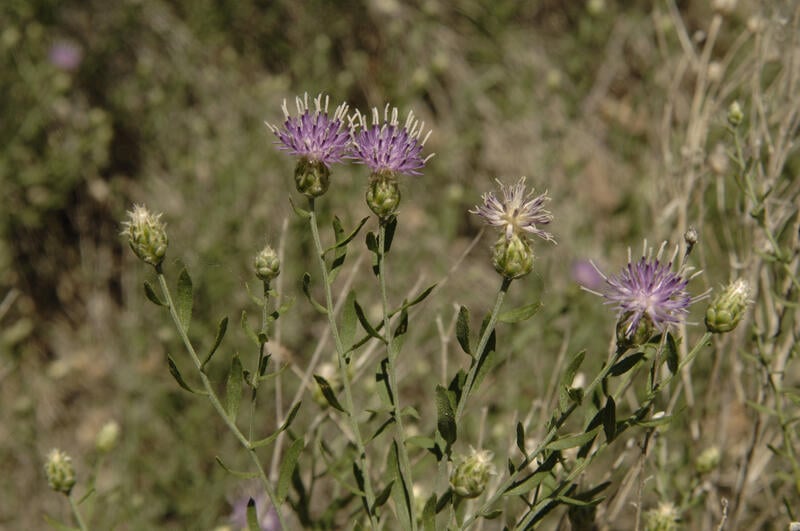
The Russian knapweed establishes expansive colonies thanks to its vigorous and far-reaching rhizomes. Its aggressive nature makes it a persistent threat in pastures, non-crop areas, and grain fields. Of particular concern is its toxicity to horses, which can cause chewing disease.
Life cycle: Perennial
Weed type: Broadleaf shrub
Where it thrives: Full sun, and moist soils
How to identify Russian knapweed:
- Thistle-like flower heads, pink to purple colored
- Bracts under the flower heads are greenish
- Basal leaves are gray-green and lobed
- Upper stem leaves are smaller with toothed edges
How to get rid of Russian knapweed: This is a difficult weed to control, even with herbicides. Combine mechanical methods with a suitable herbicide and seed competitive forage.
Class C Noxious Weeds
Class C noxious weeds are a category of weeds considered less of a serious threat compared to Class A and B. They tend to be more widespread, and their control is typically at the discretion of each county.
English Ivy (Hedera helix)
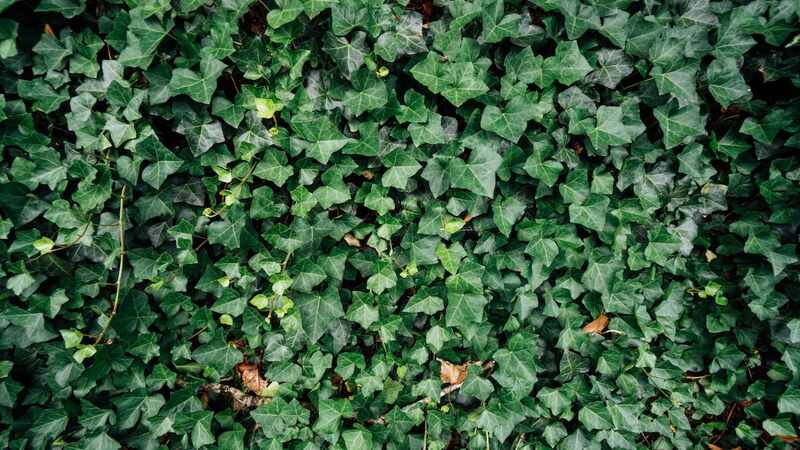
English ivy, a common vine, is recognizable by its trailing stems and glossy leaves. While it may seem harmless, this weed inhibits the regeneration of understory plants, preventing the growth of diverse vegetation. Moreover, its dense growth threatens understory and overstory trees by smothering them.
Life cycle: Perennial
Weed type: Evergreen vine
Where it thrives: It grows in a variety of soil types but does not like wet areas. Tolerates full shade.
How to identify English ivy:
- Dark green leaves with three to five lobes
- Leaves with a waxy coating
- Long, flexible stems that can grow up to 90 feet
- Small green or white flowers in fall
- Dark blue to black fruits
How to get rid of English ivy: Manual removal is a viable option to effectively remove English ivy, especially when the soil is moist. Carefully pull the vines from the ground, ensuring you remove as much of the root system as possible, and dispose of them away from the site to prevent re-rooting. In cases of extensive infestation, glyphosate can be used, following the manufacturer’s instructions.
If the weed has climbed up a tree, you don’t have to climb to remove it. Instead, cut it at your chest height all around the tree and gently peel the vine off.
Canada Thistle (Cirsium arvense)
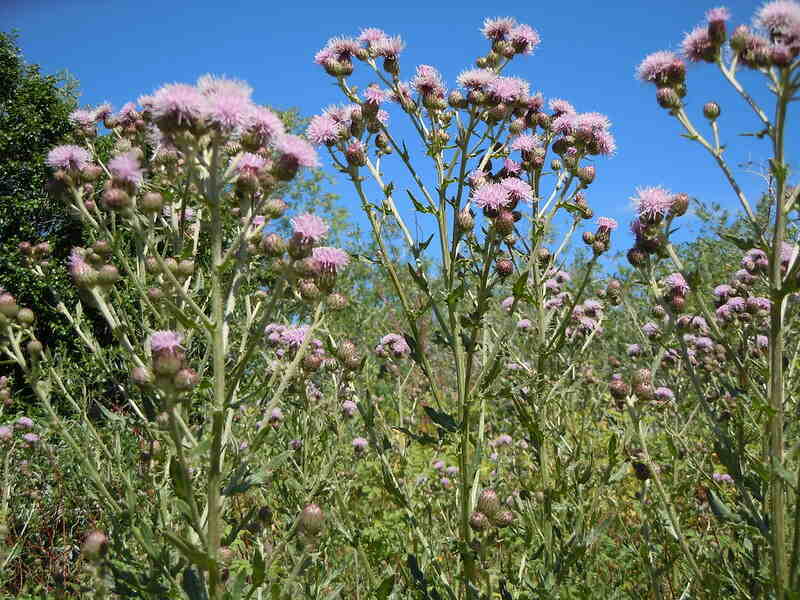
Canada thistle, a persistent intruder, quickly spreads its reach through underground rhizomes. This weed is easily recognizable by its leaves adorned with yellowish prickles along the edges, adding to its unwelcome nature. In addition, it produces small violet flowers that further contribute to its distinctive appearance.
Life cycle: Perennial
Weed type: Broadleaf wildflower
Where it thrives: Full sun, and moist soils
How to identify Canada thistle:
- 2 – 5 feet tall
- Lance-shaped leaves with wavy edges and yellowish prickles
- Teardrop-shaped pink and purple flowers
- Seedlings emerge as small rosettes in fall or early spring, with fluffy tops
How to get rid of Canada thistle: Prevention is crucial, such as using pre-emergent herbicides in spring and repeatedly mowing or cutting stands before flowering. Avoid tiling to prevent the spread of the plant’s rhizomes. Targeted herbicide application may be recommended for larger infestations, with herbicides containing aminopyralid, dicamba, or glyphosate commonly used.
Bull Thistle (Cirsium vulgare)
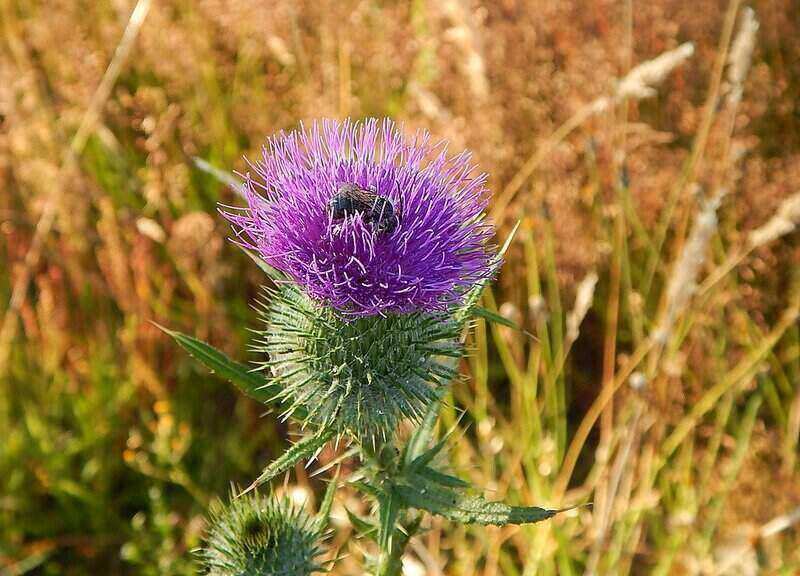
Bull thistle, a prickly plant, is characterized by its branches adorned with spines and hairs. This highly adaptable invasive weed can invade any disturbed habitat, quickly establishing dense thickets. However, the bull thistle is easier to control than the Canada thistle.
Life cycle: Biennial
Weed type: Broadleaf herbaceous plant
Where it thrives: Full sun to partial shade, and prefers nitrogen-rich soils
How to identify bull thistle:
- Branches with green or brown spines
- Leaves are hairy and prickly on the upper side and cottony underneath
- Dark pink to purple flowers in large heads
- Flower bracts have spines
How to get rid of bull thistle: Hand pulling is effective, especially for young plants, before they produce seeds. Tilling the soil can help reduce the number of plants (just make sure you’re not dealing with Canada thistle instead). In larger infestations or when manual removal is impractical, herbicides containing aminopyralid, 2,4-D, or dicamba can be applied selectively to target bull thistle.
Himalayan Blackberry (Rubus armeniacus)
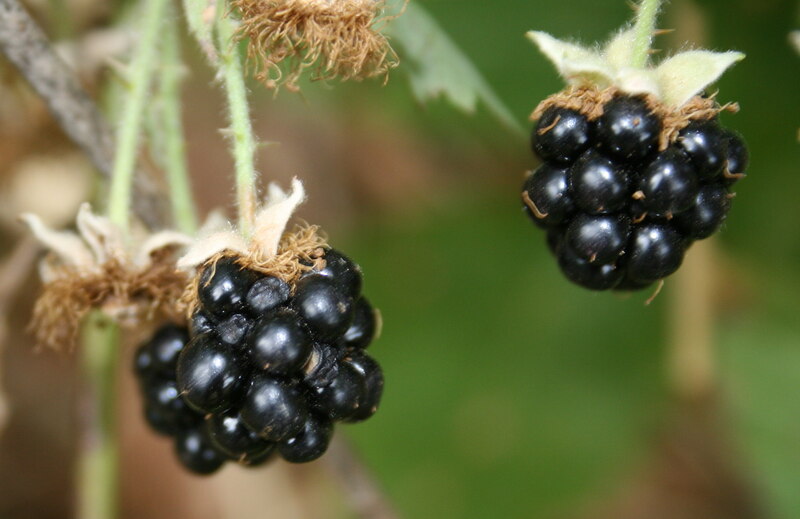
The Himalayan blackberry is a robust shrub with thick stems and formidable thorns. It bears small white flower clusters that eventually transform into red to black berries. However, this invasive plant is notorious for its aggressive spreading behavior. It can rapidly colonize and dominate landscapes, outcompeting native plants and disrupting ecosystems.
Life cycle: Perennial
Weed type: Broadleaf shrub
Where it thrives: Full sun, with loamy, nutrient-rich soils
How to identify Himalayan blackberry:
- Clusters of small white or pink flowers
- Leaflets arranged in a palmate pattern
- Oval-shaped leaves with serrated or toothed edges
- Thick, woody, and arching stems with thorns
How to get rid of Himalayan blackberry: Cut back the plant stems, leaving about a foot to track the plant, and then carefully pull back the cut stems with a rake or suitable tool, allowing space for digging up the roots. Herbicides containing glyphosate can also be used.
Reed Canarygrass (Phalaris arundinacea)
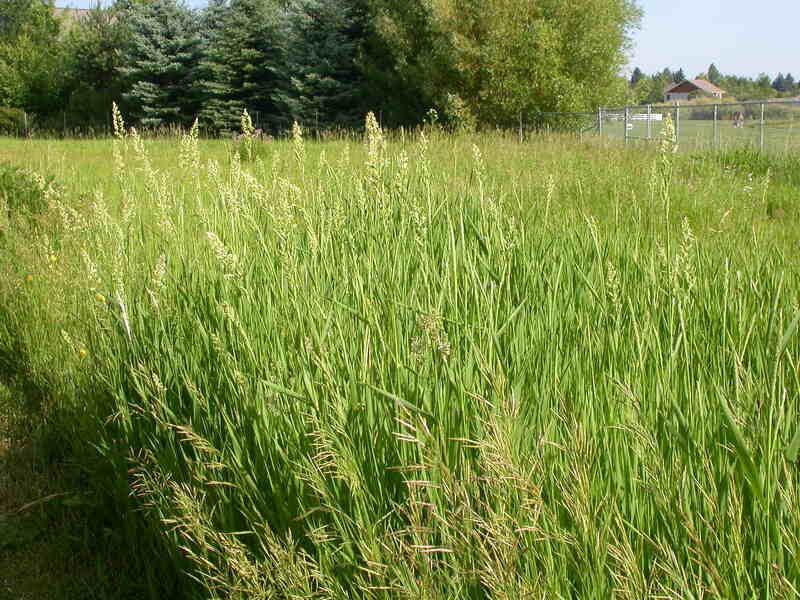
Reed canarygrass presents a significant threat to wetlands, as it outcompetes most native plant species. This invasive grass forms dense stands that possess limited wildlife habitat value. By displacing native vegetation, reed canarygrass disrupts the delicate balance of wetland ecosystems, reducing biodiversity and diminishing the quality of habitat for wildlife.
Life cycle: Perennial
Weed type: Grass
Where it thrives: Partial shade to full sun, and saturated soils
How to identify reed canarygrass:
- Densely clustered flowers in panicles with 3 florets
- Flat and hairless leaf blades
- Stems can reach 3 to 6 feet in height
How to get rid of reed canarygrass: Mowing frequently can help remove seed heads before they mature. Herbicides containing fluazifop or glyphosate can also help, but they will also kill other vegetation in the area.
Yellow Toadflax (Linaria vulgaris)
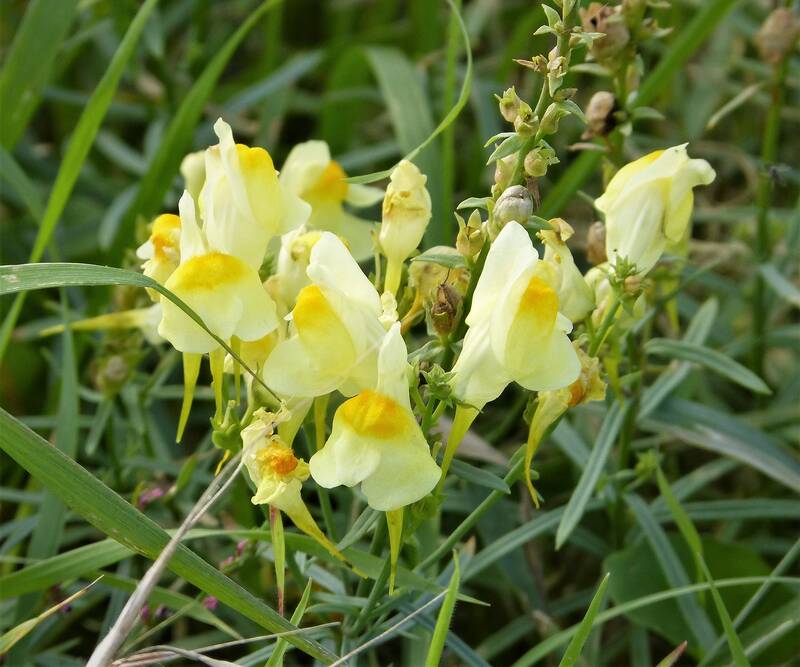
The yellow toadflax is often known as “butter and eggs” due to its distinct flower colors. This plant spreads aggressively, quickly colonizing disturbed areas and outcompeting native vegetation. While its presence may be visually striking, it is essential to note that yellow toadflax is moderately poisonous to livestock.
Life cycle: Perennial
Weed type: Broadleaf herbaceous plant
Where it thrives: Full sun, dry grassland, sandy soils
How to identify toadflax:
- Yellow flowers with orange throats resembling snapdragons
- Bad smell
- Lance-shaped, gray-green, pointed leaves
How to get rid of toadflax: Getting rid of toadflax can be challenging due to its ability to regenerate from small root fragments. Mechanical and chemical methods are often necessary to ensure successful control. Begin by employing mechanical control measures. Dig out the entire plant, including the root system, and then apply a glyphosate herbicide.
Common St. Johnswort (Hypericum perforatum)
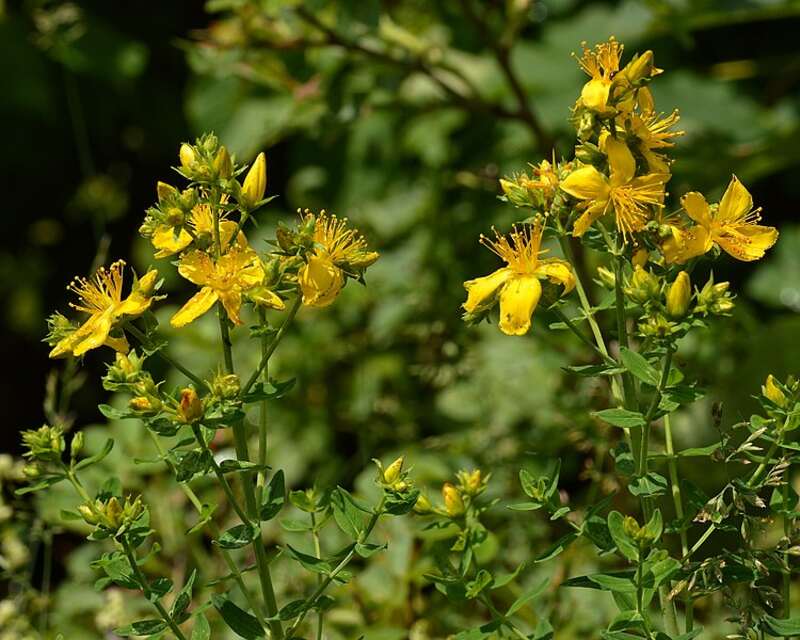
Common St. Johnswort is an herbaceous plant that spreads rapidly. However, its impact extends beyond its invasiveness. This weed contains compounds that can cause health issues in humans and livestock. When the skin is exposed to sunlight after contact with the plant, it can result in skin lesions and necrosis.
Life cycle: Perennial
Weed type: Broadleaf, herbaceous plant
Where it thrives: Full sun, and coarse-textured, gravelly, well-drained soils
How to identify common St. Johnswort:
- Clusters of yellow, star-like flowers with five petals with tiny black dots
- Upright reddish stems
- Leaves are lance-shaped, with tiny purplish-black dots
How to get rid of common St. Johnswort: Mechanical methods can be used for new or small patches by digging out the entire plant. For larger infestation patches, herbicides containing 2,4-D or metsulfuron can be used.
Field Bindweed (Convolvulus arvensis)
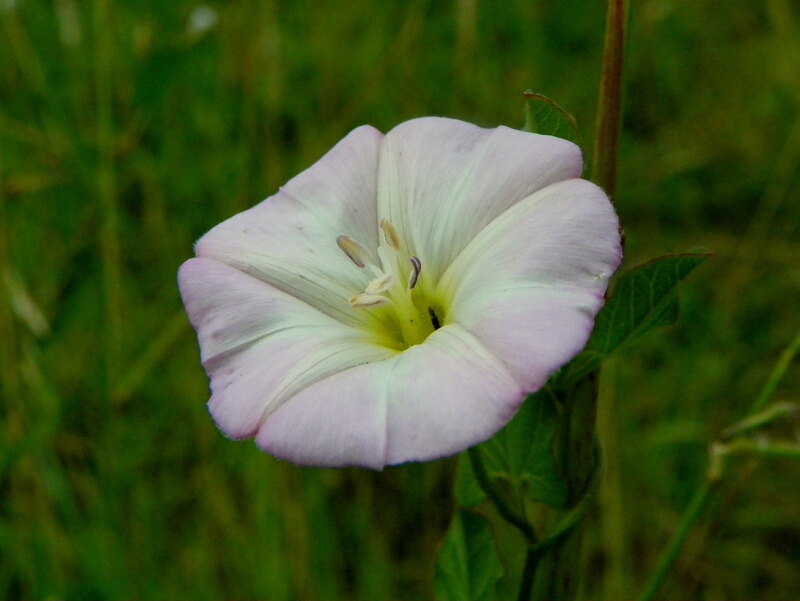
Field bindweed proves challenging to fully eliminate, often requiring ongoing efforts. Like most other weeds described so far, its aggressive nature allows it to outcompete native plant species, diminishing biodiversity and disrupting the natural balance of ecosystems. Moreover, it harms crop yields, leading to significant agricultural losses.
Life cycle: Perennial
Weed type: Broadleaf, herbaceous plant
Where it thrives: Full sun, and mesic to dry conditions
How to identify field bindweed:
- Stems are creeping and twining that grow along the ground
- Flowers are bell or funnel-shaped, white to pinkish, with two small bracts
- Leaves are alternate, arrowhead-shaped
How to get rid of field bindweed: Mechanical control is not usually effective against this weed. Instead, apply herbicides containing glyphosate in the fall and again in spring. Additional applications will be necessary once it regrows.
Yellow Flag Iris (Iris pseudacorus)
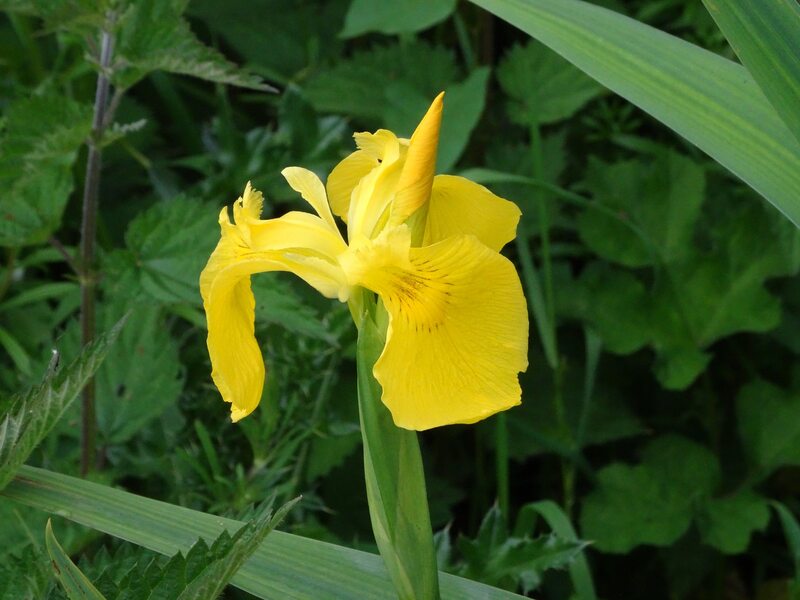
Yellow flag iris, an invasive aquatic perennial prized for its ornamental value, poses risks to livestock and humans. When ingested, it can cause illness in livestock, making it a concern for farmers and ranchers. In humans, contact with the plant can result in skin irritation.
Life cycle: Perennial
Weed type: Aquatic, herbaceous plant
Where it thrives: Full sun, boggy sites
How to identify yellow flag iris:
- Yellow flower with three sepals and three petals
- Basal leaves with a broad, flat, sword shape and stalkless
- Grows 2 to 3 feet tall along shores in shallow water
How to get rid of yellow flag iris: Use gloves to cut the plant off, being careful not to leave any rhizome fragments, as they can grow and form new plants. Dispose of the plants in trash bags, and apply herbicides containing glyphosate (formulated for aquatic settings) to the area or the stump.
Applying aquatic herbicides can be done in Washington State only by licensed applicators, so you may need to contact one if you have large patches of yellow flag iris near a body of water.
FAQ About Washington Weeds
Having invasive species, such as noxious weeds, invade your land can have detrimental effects. Not only do they detract from the aesthetics of your property, but they can also pose risks, such as:
● Erosion, leading to soil degradation and loss of land productivity
● Obstruction of waterways, affecting aquatic ecosystems and water availability
● Increased risk of wildfires
● Destruction or degradation of wildlife habitat
● Reduced land value
● Reduced diversity of native plants
Preventing invasive weeds is the most effective approach, particularly considering their resilience and the challenges of eradicating them even after years of treatment. Here are some preventive measures to consider:
● Vigilant Monitoring: Regularly inspect your property and surrounding areas to identify and address potential weed infestations early on.
● Clean Equipment and Vehicles: Clean tools, machinery, and vehicles thoroughly before moving them between different areas to avoid inadvertently introducing weed seeds.
● Use Certified Seed and Plants: Purchase certified seeds and plants from reputable sources to reduce the risk of introducing invasive weed species.
● Prevent Soil Disturbance: Minimize soil disturbance during construction or landscaping projects, as disturbed soil often facilitates the growth and spread of invasive weeds.
To effectively eliminate weeds in Washington, you can employ the following methods:
● Manual Removal: A practical approach for small weed infestations is manually pulling the weeds from the roots. Ensure complete removal, including the roots, to prevent regrowth. Do this when the soil is moist.
● Herbicide Application: In the case of large-scale infestations, herbicides can be utilized. Broad-spectrum herbicides control a wide range of weed species, while selective herbicides target specific types of weeds. Carefully read and adhere to the instructions on the herbicide labels.
● Reseed the Area: Consider reseeding the area with desirable native species or fast-growing grasses. This helps establish a dense and competitive vegetation cover, reducing weed colonization and regrowth opportunities.
Bring in the Professionals
The battle against weeds in Washington can be tough, but fear not! There is help available.
Call a Washington lawn care pro near you. We have trusted professionals in Seattle, Spokane, Tacoma, and many more cities across the state.
Main Image Credit: ca2hill / Canva Pro / License